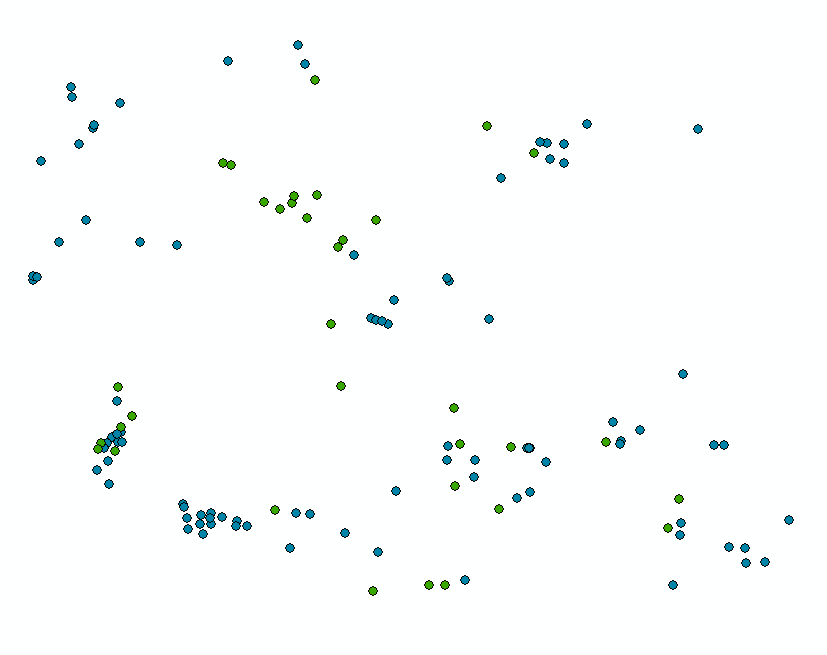- Home
- :
- All Communities
- :
- Products
- :
- Spatial Statistics
- :
- Spatial Statistics Questions
- :
- statistically comparing spatial relation between t...
- Subscribe to RSS Feed
- Mark Topic as New
- Mark Topic as Read
- Float this Topic for Current User
- Bookmark
- Subscribe
- Mute
- Printer Friendly Page
statistically comparing spatial relation between two point distributions
- Mark as New
- Bookmark
- Subscribe
- Mute
- Subscribe to RSS Feed
- Permalink
Hello, I have two point distributions representing feature type 1 (blue dots) and feature type 2 (green dots). I'd like to know whether the green dots are spatially related to the blue dots or not, e.g. have a spatially distribution independent from the blue dots. Can this be done in ArcGIS?
Best,
Tijm

- Mark as New
- Bookmark
- Subscribe
- Mute
- Subscribe to RSS Feed
- Permalink
You didn't indicate whether you had examined the options available in the
Spatial Statistics toolset An overview of the Spatial Statistics toolbox—Help | ArcGIS for Desktop
- Mark as New
- Bookmark
- Subscribe
- Mute
- Subscribe to RSS Feed
- Permalink
Hi Dan, I checked all the tools but I did not find one that suited my goal. But then again I must admit that I have very little experience with spatial statistics, so I may have overlooked something. That's why I'm asking here.
- Mark as New
- Bookmark
- Subscribe
- Mute
- Subscribe to RSS Feed
- Permalink
I guess what I was trying to get at was is there any reason for
- within group patterns, what is the pattern within each group (clustered? dispersed? random?)
- a co-association of the two point groups (given the patterns observed individually, is the combined pattern the result of proximity to the other object)
There must be a plausible reason that the resultant combined pattern is due to their presence together and a different pattern would/might be observed if the other object was absent.
EDIT
And I might add, even though the observations are classified as a group, does each member of the group behave in a similar fashion.
- Mark as New
- Bookmark
- Subscribe
- Mute
- Subscribe to RSS Feed
- Permalink
So what I'm actually studying are the distributions of several types of features from an archaeological site. They represent different types of human activities. So In the example above the blue dots are 'ovens' (related to bread baking and cooking) while the green dots are 'bins' (related to storage activities- perhaps related to food processing). Within their group, ovens or bins usually group together in one area. This clustering is significant for both groups according to nearest neighbor analysis.
There are reasons to think that members within a group don't behave in a similar fashion, as different ovens might have had different purposes. But this we do not know.
My question at the moment is whether the bins are spatially associated with ovens or not. If such a relation can be proven, the activities they are associated with are more likely to be related as well. I come a long way just visually comparing the patterns and qualitatively describing them, but I just want to know whether this pattern is also statistically significant.
- Mark as New
- Bookmark
- Subscribe
- Mute
- Subscribe to RSS Feed
- Permalink
Interesting...In that context, I will have a think since I can rule out several possibilities. You might want to begin by looking at
Near Near—Help | ArcGIS for Desktop
Near Table Generate Near Table—Help | ArcGIS for Desktop
and other proximity based tools.
Also, is there space in the intervening space where either of those activities could not possibly occur? (ie a lake...bottomless pit...whatever) This is important since it is implied that in analysing the spatial association of objects, that their presence can occur freely and no space is ruled out by an 'impedance' that is not in locational control.
I shall return with more thoughts, but focus on the things that may assist.
- Mark as New
- Bookmark
- Subscribe
- Mute
- Subscribe to RSS Feed
- Permalink
The activities happen within a site, a small fortified settlement. So architecture, mud brick walls, takes up quite some space. So yes, this is quite an impedance!
So ideally, walking distance is used to calculate distance. Just come to think of it, another approach might by to say that all features within one confined area (e.g. a room or courtyard) are related to each other and calculate statistics based on presence or absence of the other type of feature in that same area.
Edit: concerning my last thought, I still also want to be able to say whether there is a significant pattern at various distances. e.g. is a bin placed within 1 meter or 5 meter from the nearest oven?